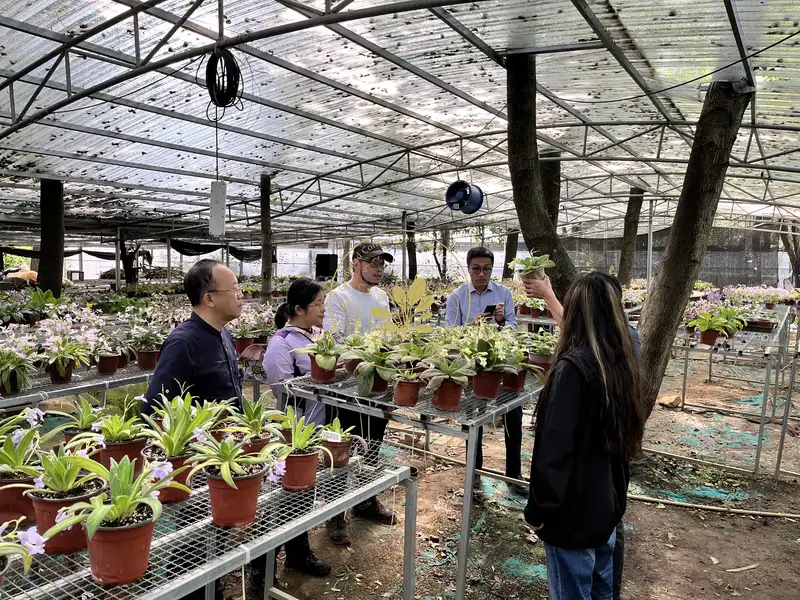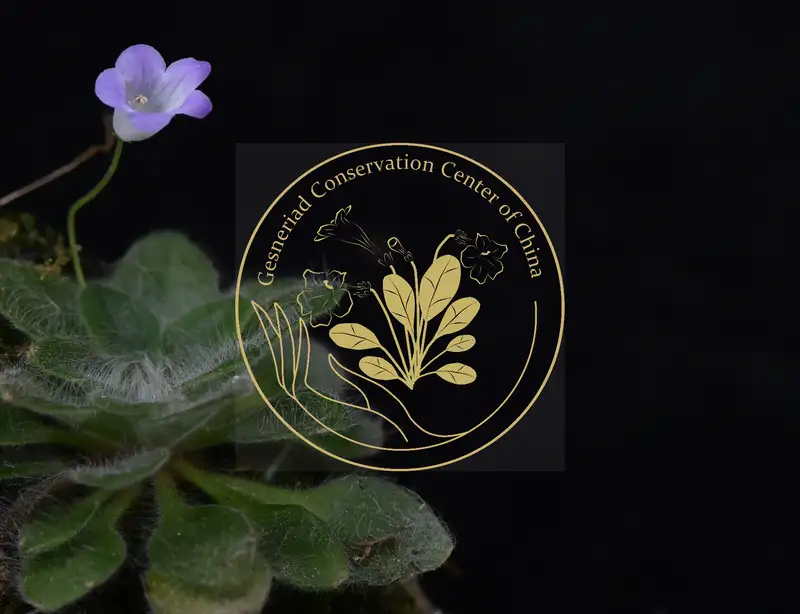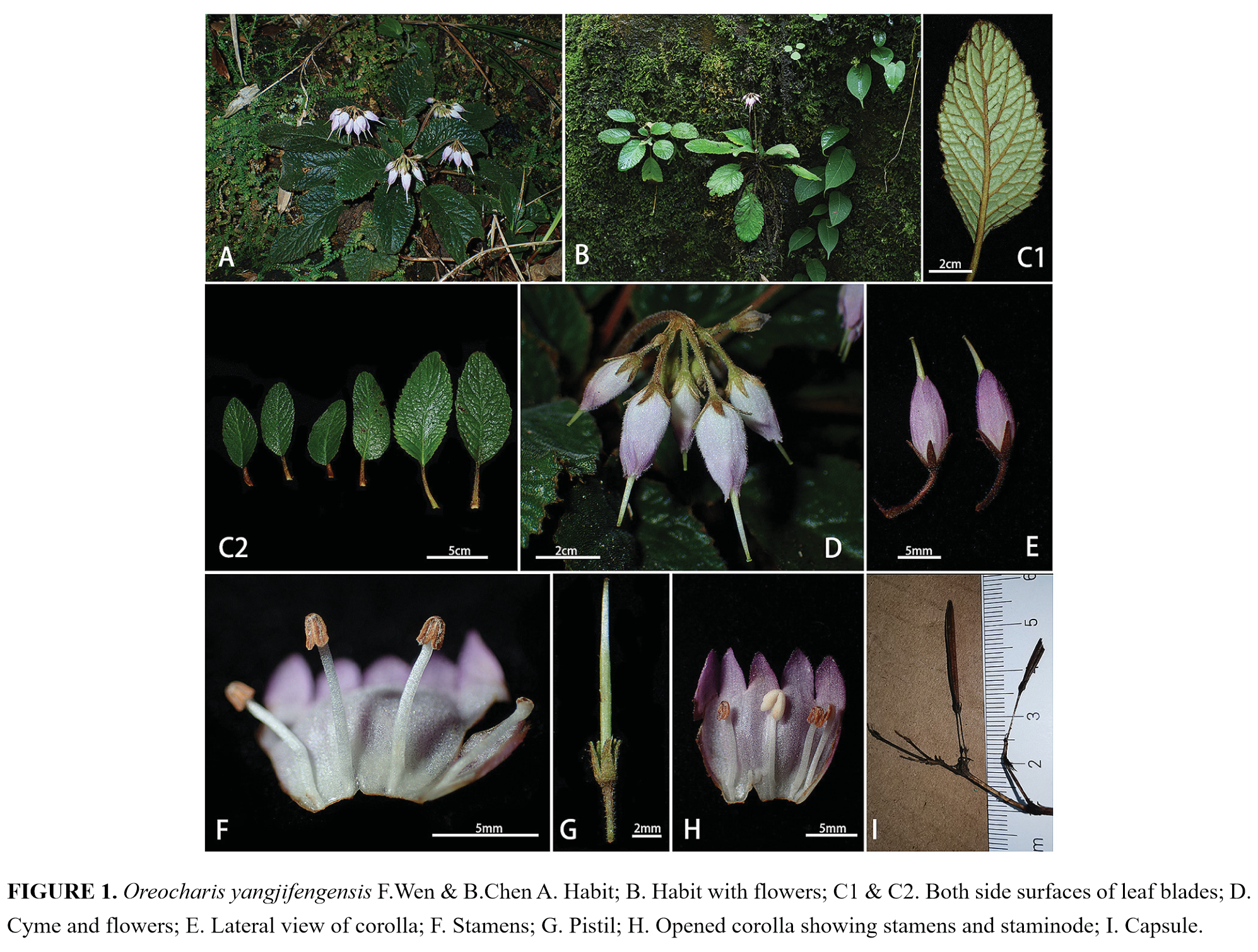No.9 Chao-Qun Li, Tian-Feng Lü, Meng-Qi Han, Yang Dong, Peng-Wei Li,Yan Liu, and Yin-Zheng Wang
Reversal versus specialization in floral morphological evolution in Petrocosmea(Gesneriaceae) & some new taxa of Petrocosmea
Journal of Systematics and Evolution: Accepted Article
ORCID iD: 0000-0002-3113-2650
https://doi.org/10.1111/jse.12541
Abstract
A widely held hypothesis in evolution is that adaptive specialization constrainsthe potential direction of future evolutionary change and thus may be irreversible,i.e., the Dollo’s law. However, this hypothesis has long been subject to debate inevolutionary biology. Floral specialization is intriguing as it is usually linked toreproductive isolation and may affect speciation. Here, following the discovery offour new taxa, we observed some interesting phenomena of reversal versusspecialization in morphology in a clade with the most specialized flowers in thegenus Petrocosmea. In the phylogenetic tree based on sequences of multiple DNAregions, the morphological reversals, especially the regain of a long corolla-tube,are nested within the branches characteristic of normally specialized flowers withshort corolla tube and highly specialized zygomorphy. Our results demonstratethat the highly specialized floral organ of this clade is still actively evolving inmultiple branches toward specialization while reversals to different ancestralstates occur in some branches. The great disturbance of ecological environment islikely a crucial factor affecting trait reversibility, such as the rapid uplift of theHimalaya-Tibet plateau. The four new taxa are treated herein taxonomically. Theflowers of this clade represent an interesting model to explore the genetic basisunderlying the evolutionary reversal versus specialization and the interplaybetween genetic factors and environmental variables.
Original Link:https://onlinelibrary.wiley.com/doi/abs/10.1111/jse.12541
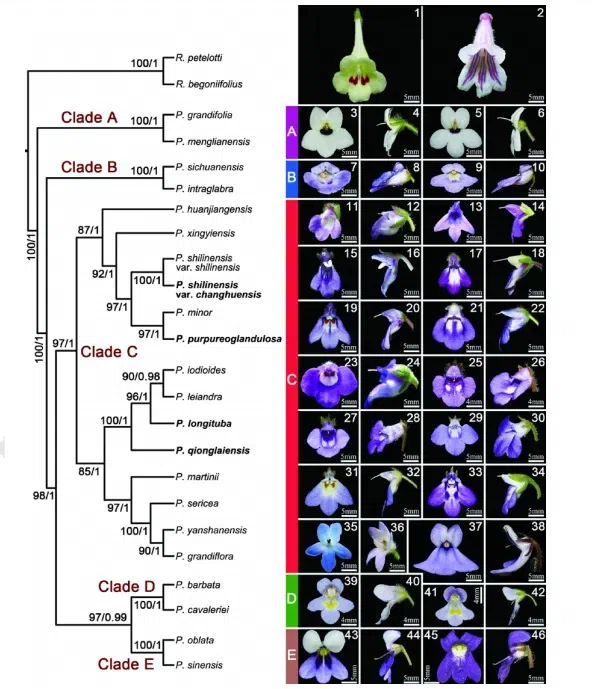
Fig. 1. The most parsimonious tree and photos of flowers of corresponding taxa.The most parsimonious tree (left) is generated from combined cpDNA andnuclear DNA data. Photos of flowers are the corresponding taxa (bold facesindicate the new taxa) sampled in the phylogenetic analysis (right). Bootstrap(BS) values are on the left side of the slash and Bayesian posterior probabilities(PP) on the right. 1-2, outgroups, 1, Raphiocarpus petelotii, 2, R. begoniifolius; 3-6, species of clade A, 3-4, P. grandifolia, face (3) and lateral (4) view, 5-6, P. menglianensis, face (5) and lateral (6) view; 7-10, species of clade B, 7-8, P. sichuanensis, face (7) and lateral (8) view, 9-10, P. intraglabra, face (9) andlateral (10) view; 11-38, species of clade C, including four new taxa, 11-12, P.huanjiangensis, face (11) and lateral (12) view, 13-14, P. xingyiensis, face (13)and lateral (14) view, 15-16, P. shilinensis, face (15) and lateral (16) view, 17-18,new variety P. shilinensis var. changhuensis, face (17) and lateral (18) view,19-20, P. minor, face (19) and lateral (20) view. 21-22, new species P. purpureoglandulosa, face (21) and lateral (22) view, 23-24, P. iodioides, face (23)and lateral (24) view, 25-26, P. leiandra, face (25) and lateral (26) view, 27-28,new species P. longituba, face (27) and lateral (28) view, 29-30, new species P. qionglaiensis, face (29) and lateral (30) view, 31-32, P. martinii, face (31) andlateral (32) view, 33-34, P. sericea, face (33) and lateral (34) view, 35-36, P. yanshanensis, face (35) and lateral (36) view, 37-38, P. grandiflora, face (37)andlateral (38) view; 39-42, species of clade D, 39-40, P. barbata, face (39) andlateral (40) view, 41-42, P. cavaleriei, face (41) and lateral (42) view; 43-46, species of clade E, 43-44, P. oblata, face (43) and lateral (44) view, 45-46,sinensis, face (45) and lateral (46) view. (15-16 Photos taken by Shui YM)
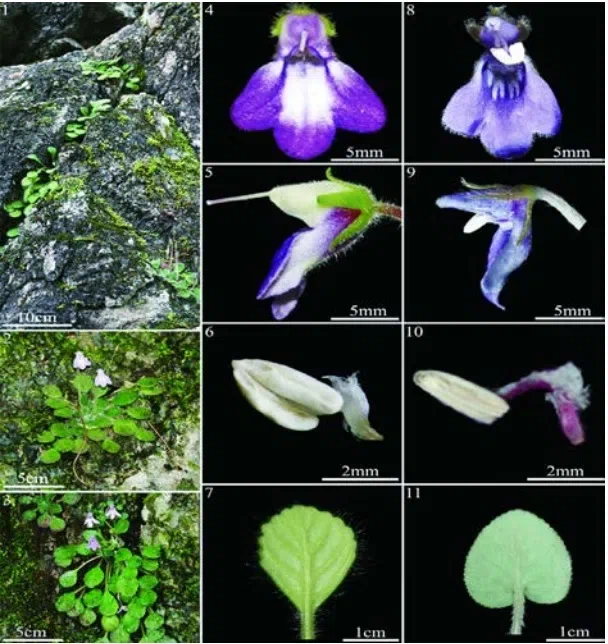
Fig. 2. Photos of P. shilinensis var. changhuensis with comparison of P.shilinensis. 1-7. P. shilinensis var. changhuensis. 1. Habitat. 2, 3. Plants withbasal leaves. 4. Flower of face view, showing two white oblong stripes extendedto the throat on abaxial corolla lip. 5. Flower of side view. 6. Stamen, showingfilaments white. 7. Leaf, showing leaf rhombic, margin crenate, base cuneate,lateral veins abaxially conspicuous. 8-11. P. shilinensis. 8. Flower of face view,showing several white stripes on the inner surface of abaxial side of corollarestricted in the tube. 9. Flower of side view. 10. Stamen, showing filamentspurple. 11. Leaf, showing leaf cordate, base cordate, margin serrulate, lateral veinsabaxially unconspicuous. (8-11. Photos taken by Shui YM.)
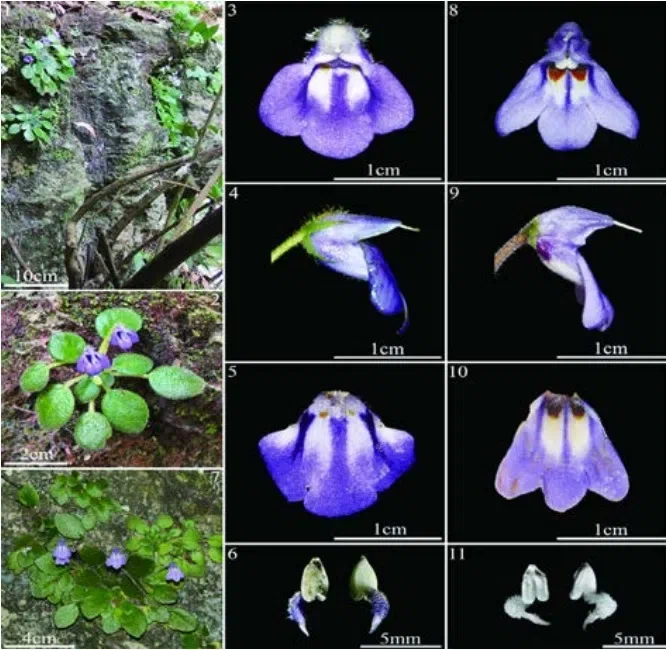
Fig. 3. Photos of P. purpureoglandulosa with comparison of P. minor. 1-6. P.purpureoglandulosa. 1. Habitat. 2. Plants with basal leaves. 3. Flower of faceview. 4. Flower of side view, showing the carinate-plicate structure straight on the adaxial side. 5. Abaxial corolla lip, showing lateral lobs broad ovate and two littleround brown spots on the inner surface of corolla tube below filaments. 6.Stamen, showing filaments slightly curved, densely purple glandular. 7-11. P. minor. 7. Plants with basal leaves. 8. Flower of face view. 9. Flower of side view,showing the carinate-plicate structure protuberance on the adaxial side. 10.Abaxial corolla lip, showing lateral lobes triangular and two big triangular brown spots on the inner surface of corolla tube below filaments. 11. Stamen, showingfilaments strongly geniculate, densely white glandular.

Fig. 4. Photos of P. qionglaiensis, P. longituba with comparison of P. iodioidesand P. leiandra. 1-4. P. qionglaiensis. 1, 2. Habitat, growing on the moist shadycliff of the limestone hill. 3, 4. Plants with basal leaves. 5-8. P. longituba. 5, 6.Habitat, growing on the moist shady cliff of the limestone hill. 7, 8. Plants withbasal leaves. 9-13. P. iodioides. 9. Face view. 10. Top view. 11. Side view. 12.Stamen. 13. Leaf. 14-18. P. leiandra. 14. Face view. 15. Top view. 16. Side view. 17. Stamen. 18. Leaf. 19-23. P. longituba. 19. Face view. 20. Top view. 21. Sideview. 22. Stamen. 23. Leaf. 24-28. P. qionglaiensis. 24. Face view. 25. Top view.26. Side view. 27. Stamen. 28. Leaf, showing petiole dark red-brown.
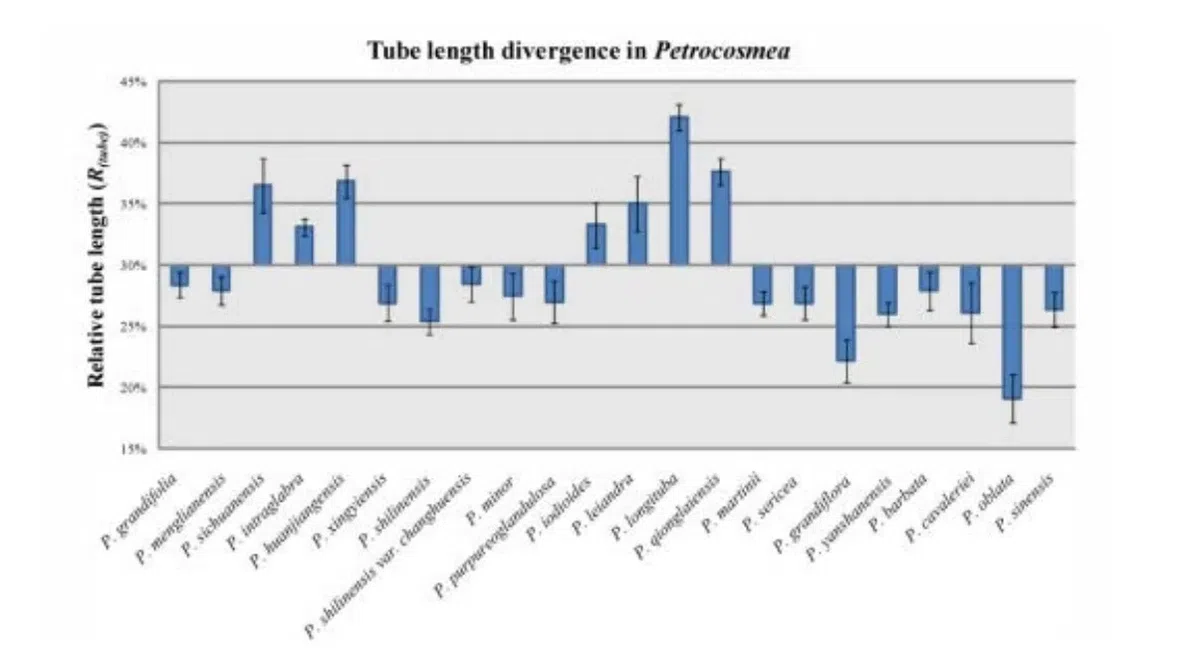
Fig. 5. Tube length divergence in Petrocosmea. X-axis: species of Petrocosmea;Y-axis: relative tube length (R (tube)). Line of 30% on Y axis was set to bettershown the difference between species with long tube and short tube. 30% is theaverage value of relative tube length (R (tube)).



